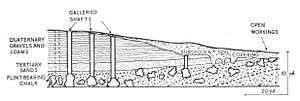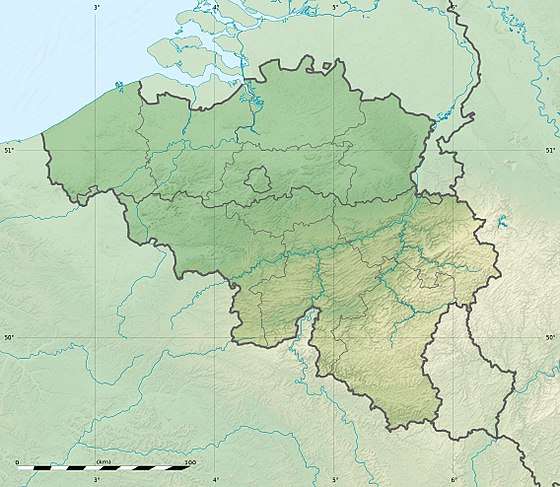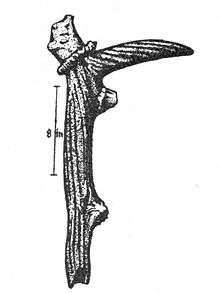Neolithic flint mines of Spiennes
| UNESCO World Heritage site | |
|---|---|
 Section of mines at Spiennes | |
| Location | Spiennes, Mons, Hainaut, Wallonia, Belgium |
| Criteria | Cultural: (i), (iii), (iv) |
| Reference | 1006 |
| Inscription | 2000 (24th Session) |
| Area | 172 ha (430 acres) |
| Website |
www |
| Coordinates | 50°25′50.772″N 3°58′43.644″E / 50.43077000°N 3.97879000°ECoordinates: 50°25′50.772″N 3°58′43.644″E / 50.43077000°N 3.97879000°E |
 Location of Neolithic flint mines of Spiennes in Belgium | |
The Neolithic flint mines of Spiennes are among the largest and earliest Neolithic flint mines which survive in north-western Europe, located close to the Walloon village of Spiennes, southeast of Mons, Belgium.[1] The mines were active during the mid and late Neolithic between 4,300 and 2,200 BC. Declared to be "remarkable for the diversity of technological solutions used for extraction" the site and its surroundings were inducted into the UNESCO's list of World Heritage Sites in 2000.[2]
Description
Discovered in 1843, the first excavations were undertaken by the mining eningeer Alphonse Briart and two others during railway construction in 1867,[3] with results presented to the International Prehistoric Congress held in Brussels in 1872.[4] Intermittent excavations have been carried out up to the present day.[5]
The Mines of Spiennes cover some 100 ha (250 acres) of downland four miles south-east of the city of Mons. The site is dotted with millions of scraps of worked flint and numerous mining pits, that Neolithic settlers have gradually turned into vertical mine shafts to depths of over 10 m (33 ft). Underneath is an elaborate man-made network of caverns accessible via the many shafts.[2][6]
A seminal stage of human inventiveness, technological and cultural application and progress, the transition between opencast and underground mining for flint nodules is impressively displayed and documented. Research has illustrated Neolithic techniques for the cutting of the flint and the extraction of large slabs of flint, that weighed up to hundreds of kilos. The nodules were extracted using flint picks. The stones were then knapped into rough-out shapes of axes, and finally polished to achieve the final state.
The SILEX'S Interpretive Centre opened in spring 2015.[7][8]
The rough-outs were exchanged over a wide area, about 150 km (93 mi), and were often polished at their destination. Polishing strengthens the final product, making the axe- or adze-head last longer. The smooth surface also aids the cutting action by lowering friction with the wood. The axes were used initially for forest clearance during the Neolithic period, and for shaping wood for structural applications, such as timber for huts and canoes.
Similar sites
The site has been compared with Grimes Graves and Cissbury in the United Kingdom, and Krzemionki in Poland, which are also sources of flint stone. However, different hard rocks were used for the polished stone axes. There are several locations in Britain where fine-grained igneous or metamorphic rock was collected from screes or opencast mines, then roughed out locally before trading on to other parts of the country. Examples include the Langdale axe industry, Penmaenmawr and Tievebulliagh.


References
- ↑ "Neolithic Flint Mines of Petit-Spiennes : Official web site". Retrieved 2007-12-16.
- 1 2 "Neolithic Flint Mines at Spiennes (Mons) - UNESCO World Heritage Centre". Whc.unesco.org. Retrieved January 24, 2017.
- ↑ Alphonse Briart et al., Rapport sur les découvertes géologiques & archéologiques faites à Spiennes en 1867 (Mons, 1872), on Google Books.
- ↑ Thomas Wilson, Arrowpoints, Spearheads, and Knives of Prehistoric Times (Washington DC, 2007), ch. 4.
- ↑ "A visit to Spiennes Flint Mines, Belgium". Journal.lithics.org. Retrieved January 24, 2017.
- ↑ "Neolithic flintstones mines in Spiennes". Minesdespiennes.org. Retrieved January 24, 2017.
- ↑ "Silexs Mons Neolithic flint mines of Spiennes". En.silexs.mons.be. Retrieved January 24, 2017.
- ↑ "Neolithic flint mines in Spiennes - SILEX'S Mons". Opt.be. Retrieved January 24, 2017.
- Bibliography
- C. Guillaume, Ph. Lipinski & A. Masson: Les mines de silex néolithiques de la Meuse dans le contexte européen. Musées de la Meuse, Sampigny 1987. (in French)
- F. Gosselin: Un site d'exploitation du silex à Spiennes (Hainaut), au lieu-dit "Petit-Spiennes". Vie archéologique 22, 1986, 33-160. (in French)
- F. Hubert: Une minière néolithique à silex au Camp-à-Cayaux de Spiennes. Archaeologia Belgica, 210, 1978. (in French)
- F. Hubert: L'exploitation préhistorique du silex à Spiennes. Carnets du Patrimoine n°22. Ministère de la Région wallonne, Direction générale de l'Aménagement du Territoire, du Logement et du Patrimoine, Namur 1997. (in French)
- R. Shepherd: Prehistoric Mining and Allied Industries. (Academic Press, London 1980).
- Société de recherches préhistoriques en Hainaut: Minières néolithiques à Spiennes (Petit-Spiennes). 1997 (in French)
- ICOMOS evaluation
- Collet, H. (2004). "Les mines néolithiques de Spiennes : état des connaissances et perspectives de recherche" (PDF). Section 10: The Neolithic in the Near East and Europe (in French). Oxford: Archaeopress. ISBN 1-84171-653-7. Retrieved 27 July 2011.
Actes du XIVème congrès UISPP, Université de Liège, Belgique, 2 – 8 septembre 2001
- H. Collet, A. Hauzeur & J. Lech, 2008. The prehistoric flint mining complex at Spiennes (Belgium) on the occasion of its discovery 140 years ago In P. Allard, F. Bostyn, F. Giligny & J. Lech, 2008. Flint mining in Prehistoric Europe: Interpreting the archaeological records. European Association of Archaeologists, 12th Annual Meeting, Cracow, Poland, 19–24 September 2006 (BAR International Series 1891): 41-77.
- H. Collet, 2014.Les minières néolithiques de silex de Spiennes. Patrimoine mondial de l’Humanité (Carnets du patrimoine 126), Institut du Patrimoine wallon, 55 p.
External links
- Image Gallery
- Visit of the Neolithic Flint mines, Interpretive Centre "SILEX'S"
- Spiennes Neolithic flint mines, archaeological team website
- Unesco list
![]()
| Wikimedia Commons has media related to Neolithic flint mines of Spiennes. |
.jpg)
.jpg)
.jpg)